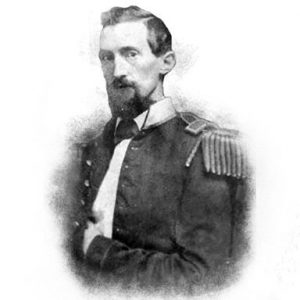calsfoundation@cals.org
Francis Asbury Shoup (1834–1896)
Francis Asbury Shoup was a Confederate general in the American Civil War who commanded a division at the 1862 Battle of Prairie Grove and created a unique set of fortifications during the 1864 Atlanta Campaign.
Francis Asbury Shoup was born on March 22, 1834, in Laurel, Indiana, the oldest of seven children of Jane Conwell Shoup and wealthy merchant George G. Shoup. He attended Asbury College, which later became DePauw University, before graduating from the U.S. Military Academy at West Point, New York, in 1855. After serving as an officer in the First U.S. Artillery during the Third Seminole War, he resigned his commission and practiced law in Indianapolis, Indiana, in 1860 before moving to St. Augustine, Florida.
When the Civil War began, Shoup joined the Confederate army, becoming a lieutenant of artillery; he was promoted to major in October 1861. He fought at the Battle of Shiloh as Major General William J. Hardee’s chief of artillery, which led to his promotion to brigadier general to date from September 12, 1862. Shoup accompanied Major General Thomas Carmichael Hindman to Arkansas in May 1862 when the latter was sent to organize Confederate activities in the state after Major General Earl Van Dorn had stripped it of most of its soldiers and materiel. Shoup was not popular with the troops in Arkansas, with one officer writing, “He is a Yankee born and I regard him as a supercilious disagreeable man. Our Brigade despises him. Indeed I know of no one who likes him except General Hindman with whom he is a favorite.”
Shoup led a division of around 5,100 Arkansas soldiers in two brigades commanded by Brigadier General James Fagan and Colonel Dandridge McRae in the December 7, 1862, Battle of Prairie Grove, participating in the savage back-and-forth fighting around the Borden House on the Confederate right. Shoup reported, “During its continuance the contest was of the most obstinate character. The enemy displayed the greatest gallantry….His losses were extremely heavy, the dead covering the ground in all directions.” While McRae’s losses were not reported, Fagan said his brigade suffered 614 killed, wounded and missing, some 41.4 percent of the 1,483 Confederate casualties of the battle.
Shoup was transferred to Mobile, Alabama, and then ordered to Vicksburg, Mississippi, where he led a small brigade of Louisiana troops, helping to repel the first attack of Union troops on the Confederate works. He surrendered with the rest of the garrison on July 4, 1863, and after being paroled, he joined the Army of Tennessee as chief of artillery. As that army fell back before the relentless approach of Major General William Tecumseh Sherman’s Union force, Shoup impressed around 1,000 enslaved people to build a series of thirty-six arrow-shaped fortifications on the Chattahoochee River in a bid to slow Sherman’s advance toward Atlanta. The Confederate troops dubbed the fortifications “Shoupades.” As he had throughout the campaign, Sherman flanked the Shoupades, which the Confederates abandoned. When John Bell Hood took command of the Army of Tennessee in 1864, Shoup served as his chief of staff.
Shoup underwent a battlefield conversion during the war and was active in the Episcopal Church after hostilities ceased, becoming a deacon on December 20, 1868, and a priest on May 2, 1869. Among other duties, he was a professor of mathematics at the University of the South in Sewanee, Tennessee, from 1869 to 1875, before leaving to lead Episcopal parishes at Waterford, New York, Nashville, Tennessee, and New Orleans, Louisiana. He returned to the university in 1883 and was a professor of mathematics, physics, and engineering until his death in Columbia, Tennessee, on September 4, 1896. He is buried in the University of the South Cemetery.
For additional information:
Castel, Albert. Decision in the West: The Atlanta Campaign of 1864. Lawrence: University Press of Kansas, 1992.
“Francis Asbury Shoup.” Find-A-Grave. https://www.findagrave.com/memorial/8830/francis-asbury-shoup (accessed June 25, 2021).
“Francis Asbury Shoup,” National Park Service. https://www.nps.gov/vick/learn/historyculture/francis-asbury-shoup.htm (accessed June 25, 2021).
Hewett, Janet B., et al., eds. Supplement to the Official Records of the Union and Confederate Armies. Wilmington, NC: Broadfoot Publishing Co., 1994–2001, vol. 4, p. 61, 69.
Raab, James W. Deliverance from Evil: General Francis Asbury Shoup, C.S.A. West Conshohocken, PA: Infinity Publishing, 2012.
Shea, William L. Fields of Blood: The Prairie Grove Campaign. Chapel Hill: University of North Carolina Press, 2009.
“Shoup, Francis Asbury.” An Episcopal Dictionary of the Church. https://www.episcopalchurch.org/glossary/shoup-francis-asbury/ (accessed June 25, 2021).
Warner, Ezra J. Generals in Gray: Lives of the Confederate Commanders. Baton Rouge: Louisiana State University Press, 1959.
Wilson, James Grant, and John Fiske, eds. Appleton’s Cyclopedia of American Biography, Vol. V. New York: D. Appleton & Co., 1888.
Mark K. Christ
Central Arkansas Library System
 Civil War through Reconstruction, 1861 through 1874
Civil War through Reconstruction, 1861 through 1874 Military
Military Francis A. Shoup
Francis A. Shoup 



Comments
No comments on this entry yet.